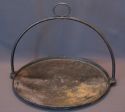griddle
| Nom de l'objet : | griddle |
| Catégorie de l'objet : | Tools & Equipment for Materials |
| Sous-catégorie de l'objet : | Food Processing T&E |
| Matériaux : | iron |
| Numéro d'accession : | 1967.27 |
| Province d'origine : | New Brunswick |
| Pays d'origine : | Canada |
| Province d'utilisation : | New Brunswick |
| Pays d'utilisation : | Canada |
| Culture : | Canadian |
| Date de fin de production : | c. 1800 |
| Commentaires : | Dropped at the mouth of the St. John River during the warm months of 1783, the Loyalists were provided with basic provisions ? blankets, tents, clothing, and tools. The first winter, however, dealt a huge blow to the struggling refugees. Many lives were lost due to the frigid cold and lack of nourishing food. For those that survived, the prospect of land grants, stands of lumber and firewood, and abundant hunting and fishing held the promise of a better life. Though they knew it would not be built overnight, Loyalists recognized the opportunity to construct a new society and economy, and many were already accustomed to migration, resettlement and hard work. From 1784 until well into the 1790s, Loyalists moved up the St. John River to Hampstead, Wickham, Gagetown and the Grand and Washademoak Lakes. Conflict naturally arose between the pre-Loyalist settlers and the Loyalists over land titles, eventually bringing about the controversial re-granting of most lands in favour of the Loyalists. In the first years, the Loyalists made do with whatever could be made by hand. Wooden tools and utensils were common. Settlers grew linen and wool on the farm and wove it into clothing and blankets. Blacksmiths soon set up their trades providing cooking pots, griddles and grills. Settlement along the waterways soon enabled a thriving river trade to develop, bringing access to finer tools and equipment such as tin moulds for candles and pewter serving bowls from Saint John or from far away London. This iron griddle belonged to the Charles MacAlpine family. Charles MacAlpine (1770-1852) was born in Glasgow, Scotland, the son of Peter MacAlpine (born c.1726) and Elizabeth Watters (born c.1732). The MacAlpines came to New Brunswick with the Loyalists in 1783 and initially settled on Lower Musquash Island, south of Gagetown. In 1794 Charles married Christean Balmain (1771-1863) and had twelve children that intermarried with other Loyalist families. More than likely after the first major freshet in the St. John River valley, the family removed itself to higher ground on Otnabog Lake, Hampstead Parish, where the family remained until the late 20th century. A brother, John, settled at the Narrows, Washademoak Lake. When Christean died in 1863 at the age of 92, her obituary in the Religious Intelligencer read: "d. Cambridge (Queens Co.) Tuesday 2nd inst., at h[er] son?s residence, Christian w/o late Charles MacALPINE, age 92. She was born at Glasgow, Scotland and emigrated to this Province with the Loyalists at which place she resided until her death; being the mother of 12 children, 81 grandchildren 46 great grand children, one great great grandchild. On Friday 5th her body was confined in the narrow house confined for all living, in hopes that her spirit was basking in the sunbeams of immortal light, in the presence of her saviour. Sermon by Rev. John Reed, Wesleyan minister of Gagetown. |
| Hauteur : | 34 |
| Largeur : | 42 |
| Unité de mesure linéaire : | cm |
| Établissement : |
Queens County Heritage
 Facebook-Queens County Heritage Facebook-Queens County Heritage
 Twitter-Queens County Heritage Twitter-Queens County Heritage
|
| Ville de l'établissement : | Gagetown |
| Province de l'établissement : | New Brunswick |
Coordonnées de cette page web
-
Pour proposer des corrections ou des mises à jour sur cette page, veuillez contacter directement le Réseau canadien d’information sur le patrimoine (RCIP).
